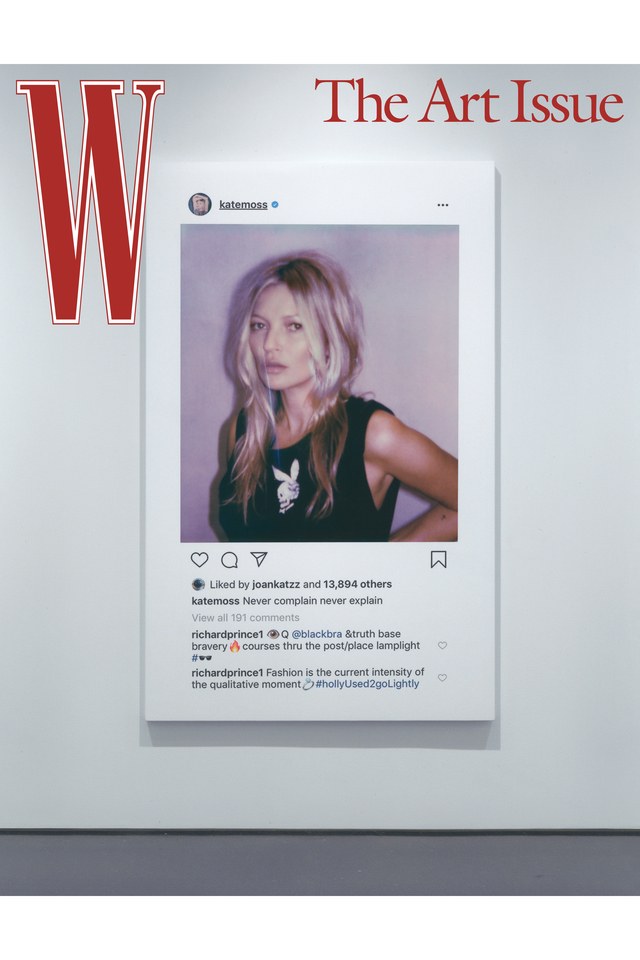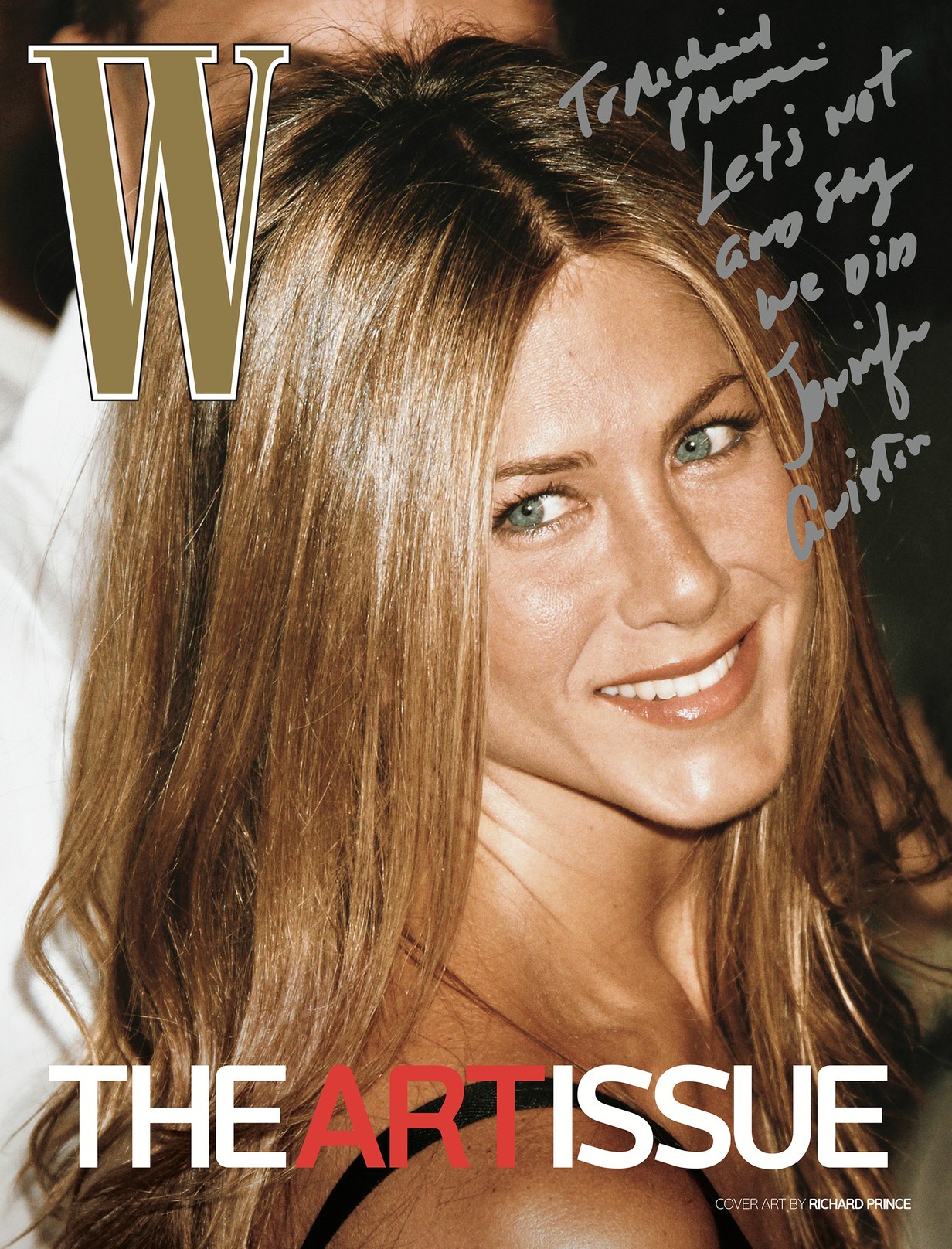#katemossbyrichardprince: Art for the Social Media Age
Derek Blasberg October 31, 2019 9:00 am
Richard Prince says he’s “post place.” Physically, the artist is in an Uber and on his way to LaGuardia Airport to catch a flight to Detroit. He’s talking to me on the phone and at the same time manipulating the image of
Kate Moss that appears on the cover of this issue, and finalizing his captions, in a language he calls Birdtalk. Figuratively, however, Prince can be nowhere and everywhere at the same time, thanks to the power of technology. “I don’t create in any particular place anymore—not in a studio, not at a fixed address. I’m just on my phone, making art, like it’s an electronic paintbrush.”
When Prince moved to New York from Braintree, Massachusetts, in the early 1970s, the term was “post studio.” “An artist would create something outside of their studio, photograph it, and then that’s what they’d show in the gallery,” Prince says. Specifically, he’s referring to post-minimalist and land artists. “Most of us have only seen [Robert Smithson’s]
Spiral Jetty or [Walter De Maria’s]
The Lightning Field in photographs. I’ve never been to Michael Heizer’s house,” he says. “That’s what intrigued me about Twitter and Instagram. It’s just an updated idea of that type of practice.”
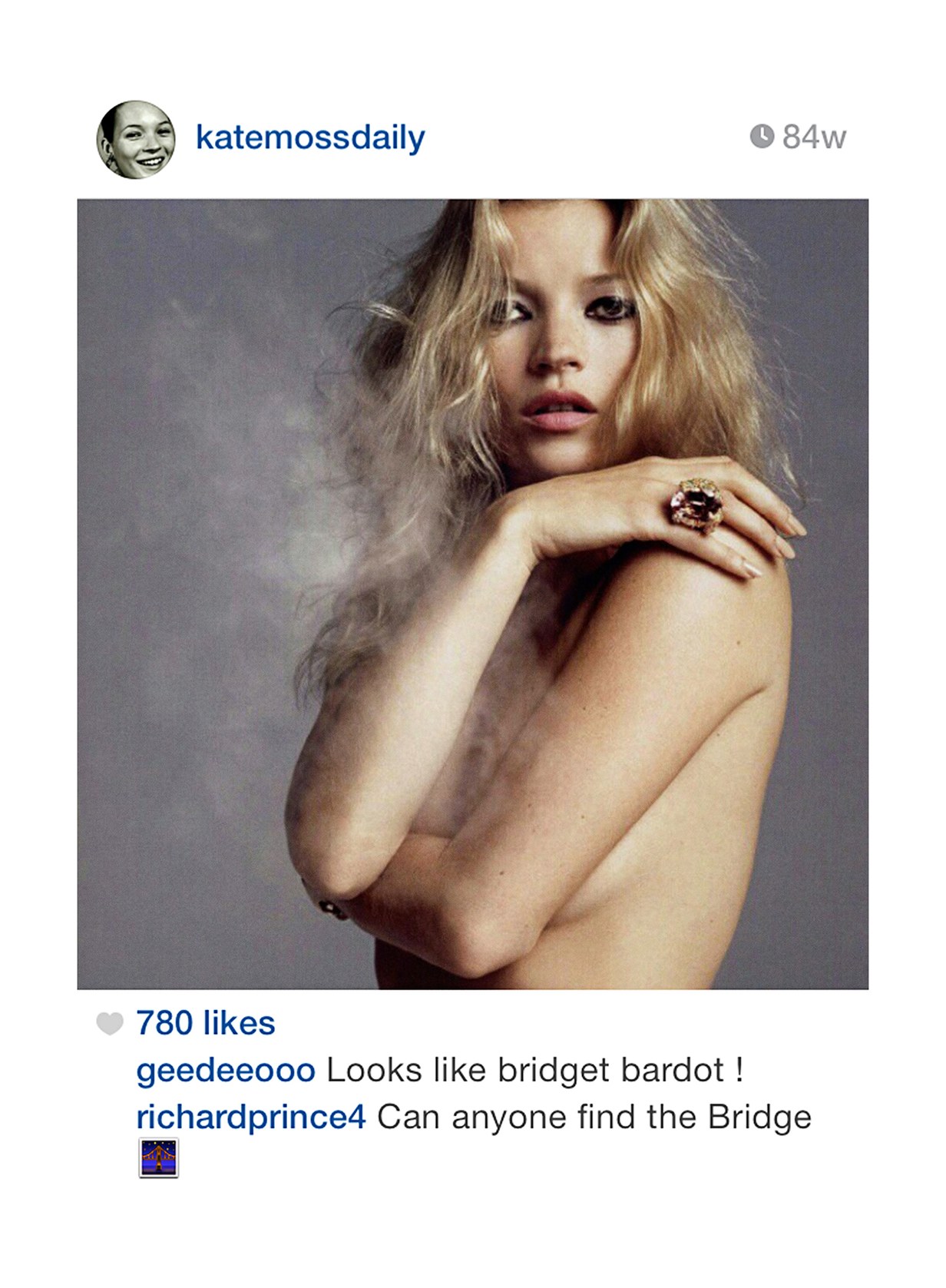
Instagram painting of Kate Moss by Richard Prince from 2014.
Artwork by Richard Prince.
Prince discovered Instagram through Twitter, which he discovered when his then-teenage daughter introduced him to Tumblr. “Twitter is editorial and Instagram is advertising,” he says. Although best known for his “Nurse” paintings, “Joke” paintings, and photographs (of photographs) of cowboys and the American West, which today sell for millions of dollars, the artist has never shied away from social media and new technology. In December 2013, he sold “The Family,” 11-by-14-inch sheets of paper printed with recent photo-text Tweets about his relatives, for $12 each at Karma’s Holiday Book Market, in New York. “The language I started using to make ‘comments’ was based on Birdtalk. Non sequitur. Gobblygook. Jokes. Oxymorons. ‘Psychic Jujitsu,’ ” he wrote on his website in 2014. “Short sentences that were funny, sweet, dumb, profound, absurd, stupid, jokey,
Finnegans Wake meets
Mad Magazine meets ad copy for
Calvin Klein.”
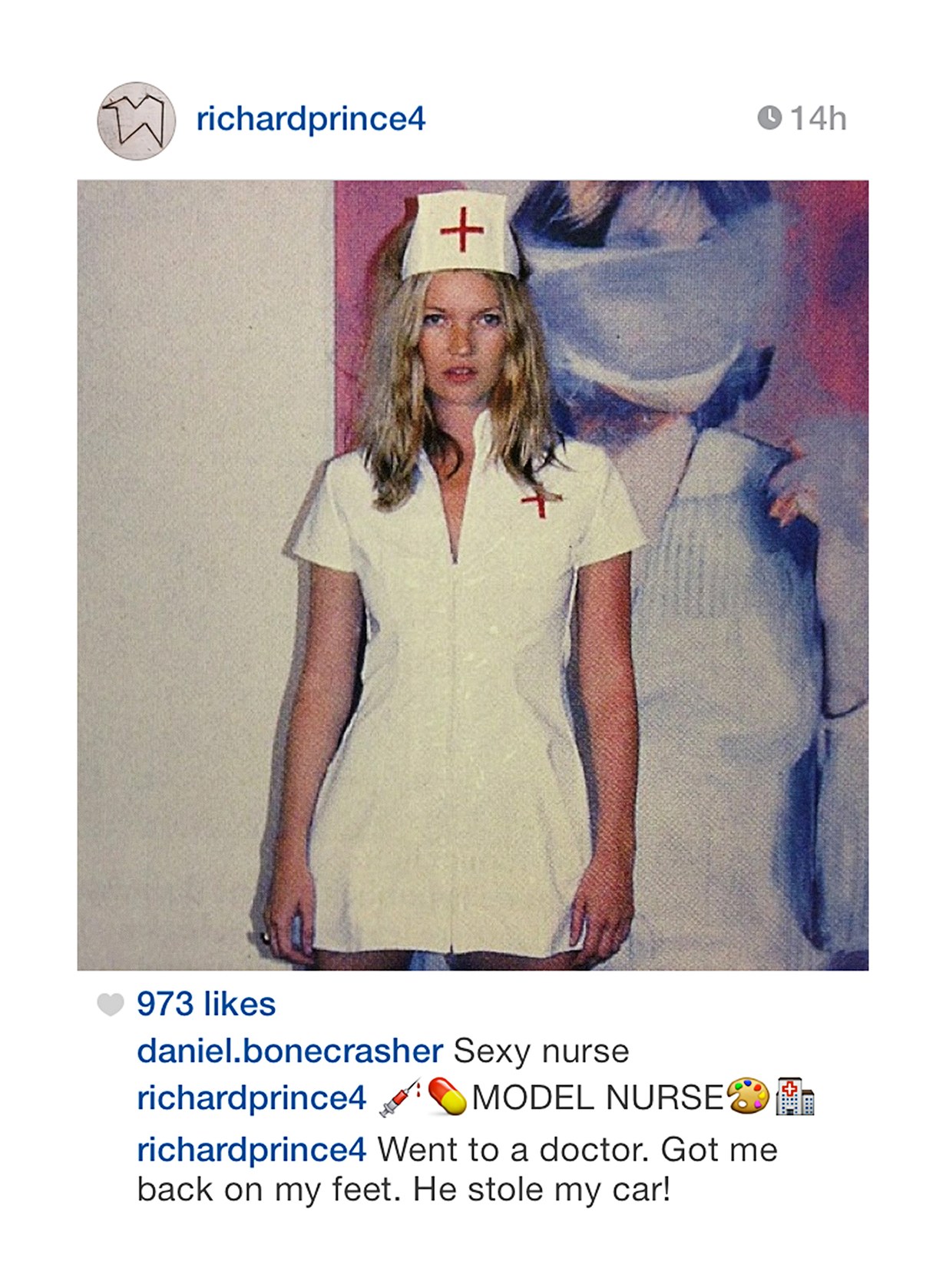
Instagram painting of Kate Moss by Richard Prince from 2014.
Artwork by Richard Prince.
To create his Instagram paintings, Prince peruses his feed—“I wouldn’t say I’m addicted, but I probably do spend too much time on my phone”—then screen grabs, captions, and prints the appropriated imagery on an ink-jet in his studio. He says the process is “a variation of the silk screen and a dark room.” He’s gone through several handles, including @richardprince4 and @richardprince1234, because he has been kicked off Instagram for violating its nudity policies numerous times. (Moss’s favorite picture by Prince, which is no longer on the platform, is of a topless cowgirl on a motorcycle.) Today he uses a private account.
“When I started using Instagram, I had no idea what I was doing,” he says, adding that he ventured down some fascinating rabbit holes. (An example: the American rapper who goes by the name Junglepussy.) “Entering territory that you didn’t know anything about is exciting. It’s about a surprise, and usually you end up doing everything the wrong way—like when
Warhol would misprint a silk screen. Those were always the best. That meant it was actually him doing them.”
Moss was one of the first subjects of Prince’s inaugural series of Instagram paintings, which were exhibited at the
Gagosian galleryin New York in September 2014. “She didn’t know I was doing it, which was part of the attraction,” he explains. “Usually, when you do a portrait of someone they’re right in front of you. But now you don’t have to come and sit for me.”
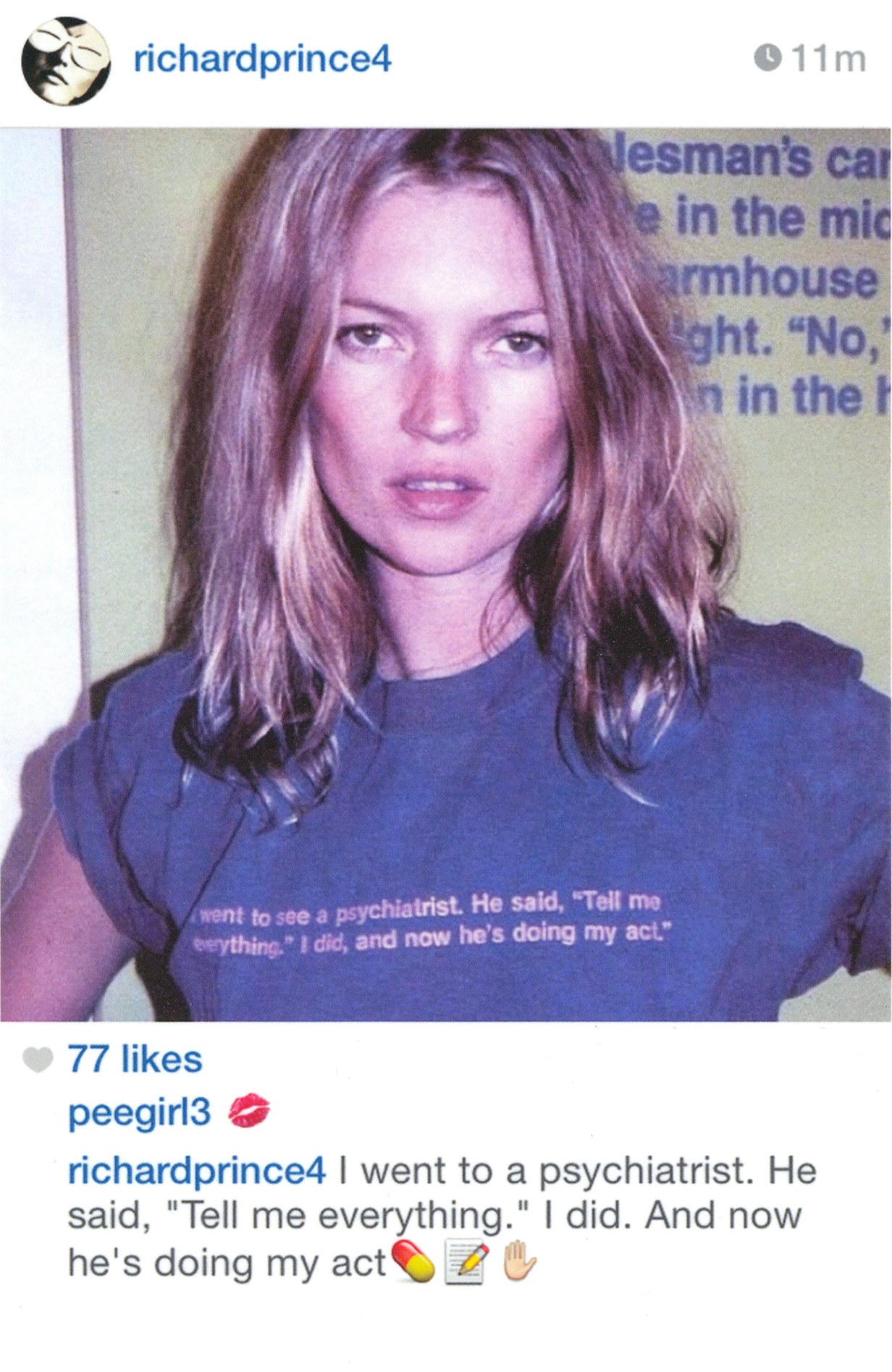
Instagram painting of Kate Moss by Richard Prince from 2014.
Artwork by Richard Prince.
At the time, brand new to the platform, Prince didn’t realize that it wasn’t actually Moss posting pictures of herself—the image he wound up using was on the feed of one of Moss’s fans. Establishing herself as a top model in the pre-digital era, Moss shied away from social media and rarely did interviews. In 2016, she started the Kate Moss Agency in London, which represents models like Jamie Bochert and Jordan Barrett and performers including
Rita Ora and
Gwendoline Christie. An official Instagram account appeared at the agency’s launch, making it Moss’s first bona fide foray onto the World Wide Web. “It’s important for the talent because clients use it to cast,” she told me via an emailed interview. (Old habits die hard.) “I don’t have a personal account, as I like to keep things private.”
What appealed to Moss about this particular project was the mix of old and new, the familiar and unfamiliar. Her boyfriend, Nikolai von Bismarck, photographed her using a Polaroid camera, and then together the two of them decided which images they’d send to Prince to be reprocessed as an Instagram painting. “I love Polaroids,” Moss says. “They are old-school, but, like digital, they give you instant gratification.”
“They call it photogenic, but the way she translates [her image] is more special,” Prince says. “She’s like the girl next door who is actually next door.” Prince first photographed Moss for
Artforumin 2003, and he remembers that she showed up to the shoot alone, no entourage, and was down-to-earth on set. “She didn’t act like a maestro,” he says. As the hashtag in his
W cover portrait suggests—#hollyUsed2goLightly—he sees her as a modern-day Holly Golightly, the main character in
Truman Capote’s Breakfast at Tiffany’s. “She has that attitude where she wakes up in the morning, splashes cold water on her face, and that’s how good it’s gonna get. Which is pretty good. I’m sure the same thing happens with
Brad Pitt. She doesn’t need wigs, makeup, eyelashes, jewelry. She doesn’t need a stylist. That’s what I like about her.”
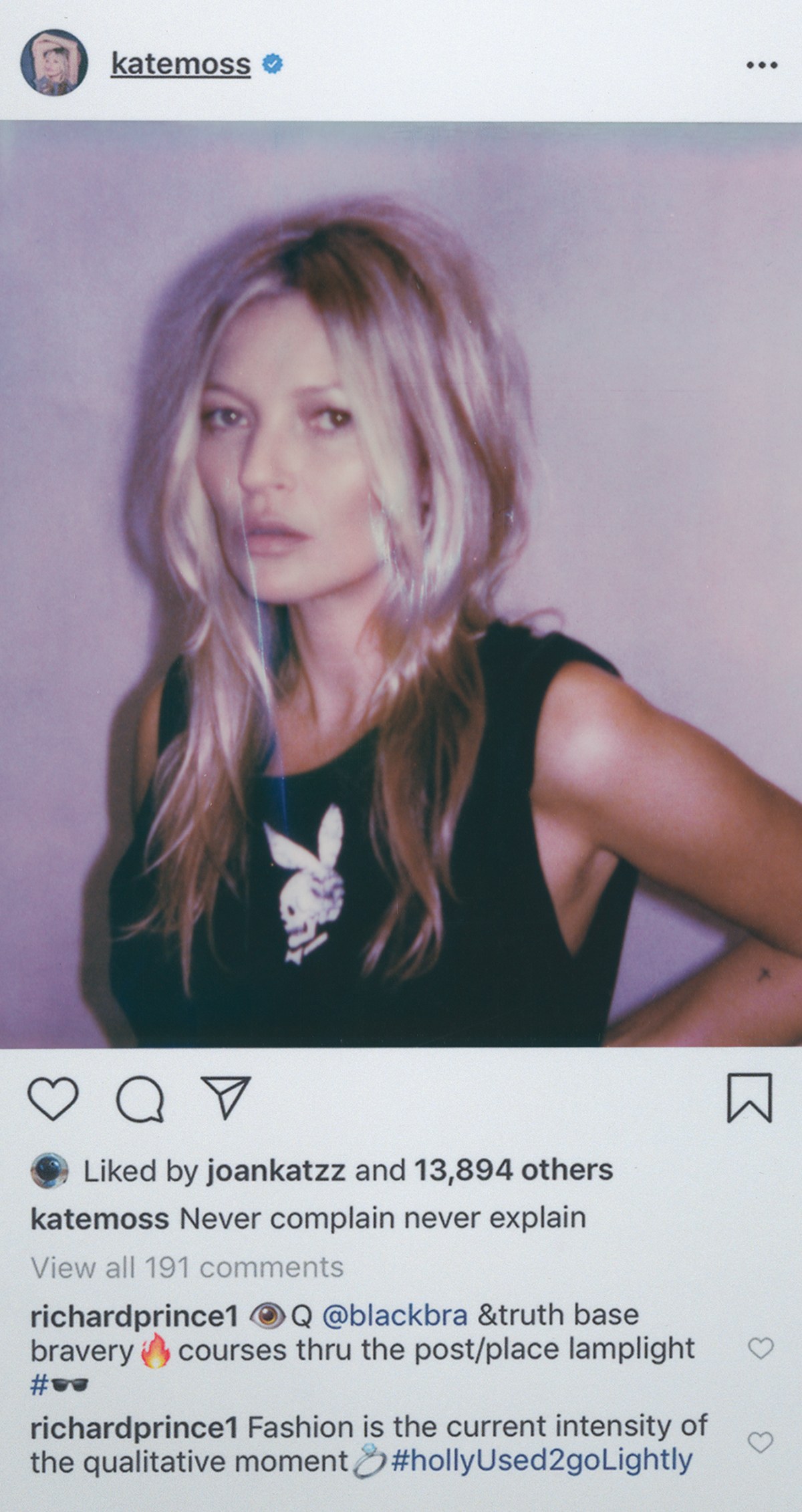
Moss wears a vintage Richard Prince T-shirt.
Artwork by Richard Prince; Photographed by Nikolai von Bismarck; Styled by Max Pearmain.
Prince was on his way to Detroit to install new Instagram paintings at the Museum of Contemporary Art Detroit. Although the show, which opened in October, is the first museum exhibition of this body of work, his Instagram paintings have made their fair share of headlines in the half decade since they first appeared. There have been lawsuits about copyright infringement, some of which are still ongoing. In 2015, a woman called Missy Suicide, founder of the alternative-pinup collective the Suicide Girls, began selling her own versions of Prince’s Instagram paintings after users alerted her that some of the Suicide Girls were featured in the series. She used the same images he had lifted off Instagram to create replicas, but sold them for $90, which was 99.9 percent off the reported gallery price of $90,000. In 2017, Prince renounced an Instagram portrait of First Daughter
Ivanka Trumpas an artistic protest to the incumbent president. Eight days before her father’s inauguration, he tweeted: “Not a prank. It was sold to IvankaTrump & I was paid 36k on 11/14/2014. The money has been returned. SheNowOwnsAfake.” On his website Prince wrote: “I don’t want anything to do with the Trumps. And I don’t want them to have anything to do with me. Redacting Ivanka Trump’s portrait was an honest choice between right and wrong. Right is art. Wrong is no art. The Trumps are no art.”
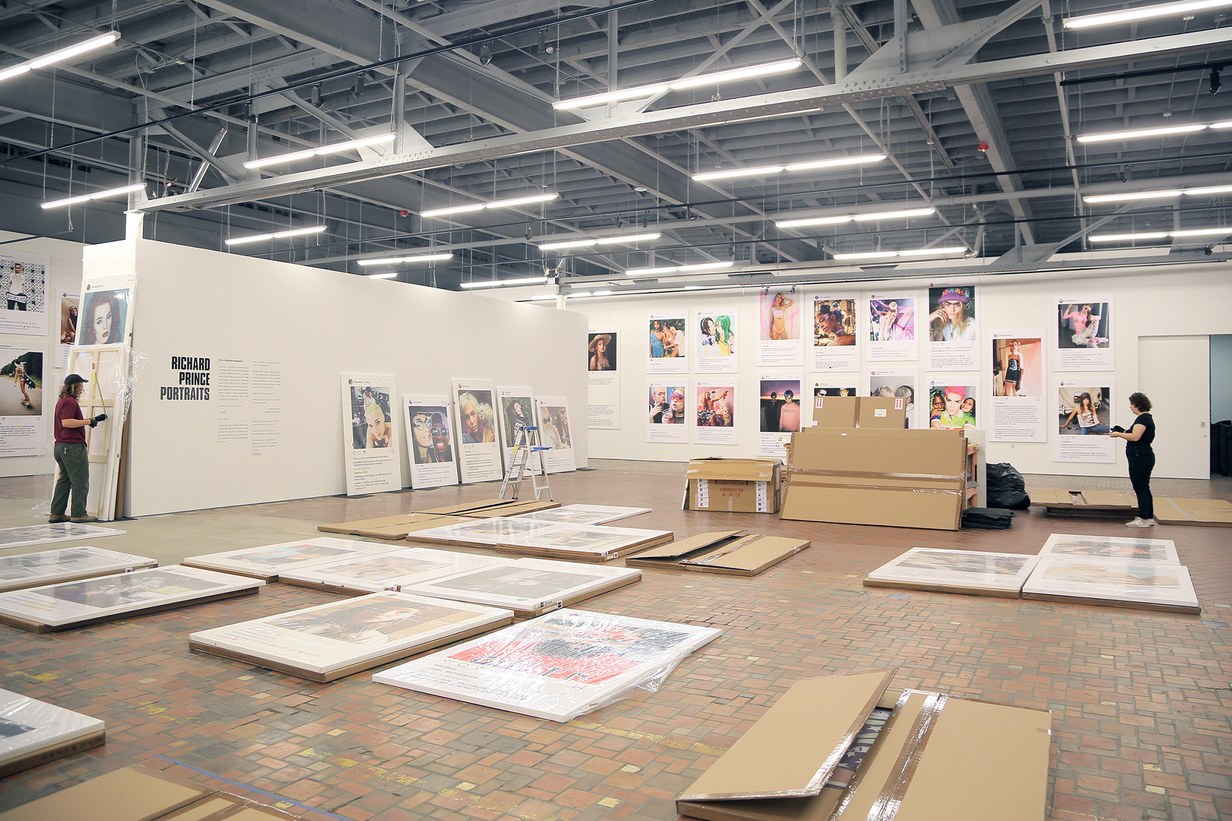
Workers installing the Richard Prince:
Portraits exhibition, which runs October 25, 2019-January 5, 2020, at the Museum of Contemporary Art Detroit.
Photograph by Pat Elifritz.
Following his visit to Detroit, Prince is back in an Uber and coming home from LaGuardia. He is pleased with the salon-style hanging at MOCAD and the new dimensions of the paintings—some of the Birdtalk captions are so long that the canvases run the entire height of the gallery. In the car, he ponders his muses. “I’m rereading the Plimpton-Stein oral biography of Edie [Sedgwick] as we speak,” he tells me. “She flamed out. Brief. Kate, on the other hand, has remained in and out of the bright-hot, white light/white heat of the spotlight. Not an easy thing to do.
Charlotte Rampling also comes to mind.” Does anyone know if she’s on Instagram?
source | wmagazine
